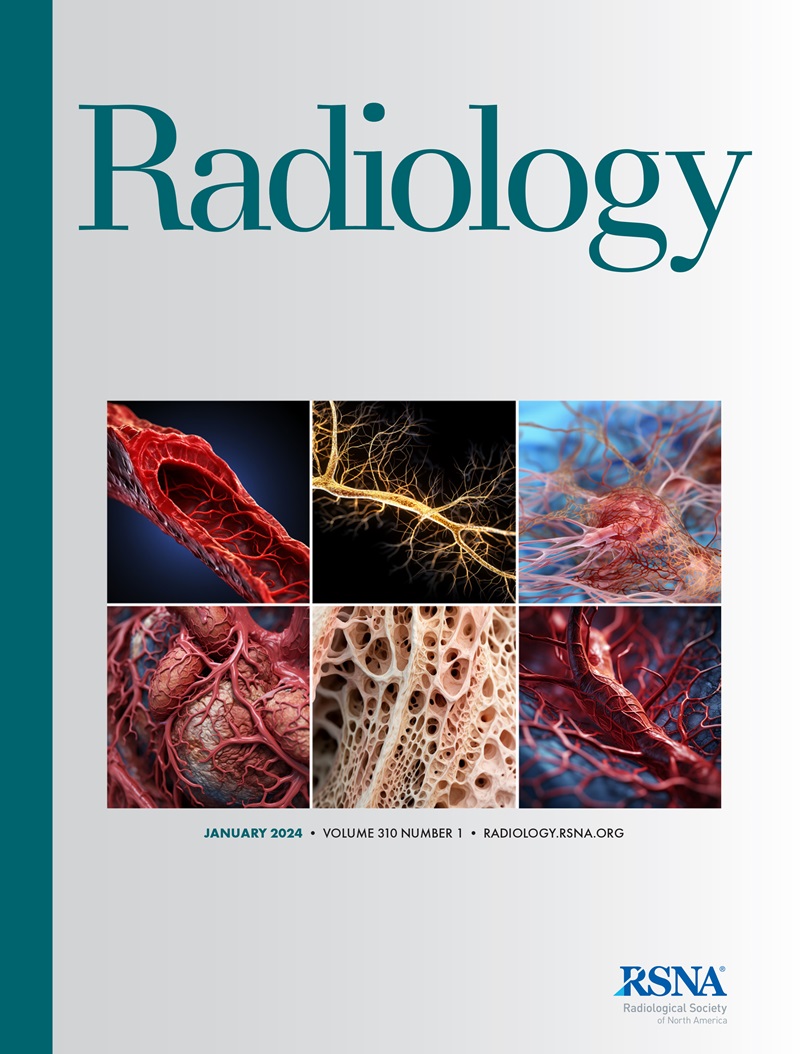Yao-Jun Zhang, Jinbin Chen, Zhongguo Zhou, Dandan Hu, Juncheng Wang, Yangxun Pan, Yizhen Fu, Zili Hu, Li Xu, Min-Shan Chen
求助PDF
{"title":"Transarterial Chemoembolization with Radiofrequency Ablation versus Surgical Resection for Small Late-Recurrence Hepatocellular Carcinoma.","authors":"Yao-Jun Zhang, Jinbin Chen, Zhongguo Zhou, Dandan Hu, Juncheng Wang, Yangxun Pan, Yizhen Fu, Zili Hu, Li Xu, Min-Shan Chen","doi":"10.1148/radiol.241096","DOIUrl":null,"url":null,"abstract":"<p><p>Background Radiofrequency ablation (RFA) has comparable clinical outcomes to surgical resection (SR) for treating small recurrent hepatocellular carcinoma (HCC). However, whether combined transarterial chemoembolization (TACE) with RFA (hereafter, TACE-RFA) outperforms SR for treating small late-recurrence HCCs remains unknown. Purpose To compare the clinical outcome of TACE-RFA with that of SR in patients with small late-recurrence HCCs. Materials and Methods This randomized clinical trial recruited patients between July 2013 and March 2019. Patients with small late-recurrence HCCs (a single recurrent HCC nodule [≤ 5 cm in diameter] or three or fewer nodules [each ≤ 3 cm in diameter] and recurrence at least 12 months after radical therapy of primary HCC) were randomly assigned to receive TACE-RFA or SR. The primary end point was overall survival (OS). The secondary end points included recurrence-free survival (RFS) and the incidence of complications. OS and RFS were assessed using the Kaplan-Meier method and log-rank test. Results In the intention-to-treat analysis, 210 patients (mean age, 52 years ± 12 [SD]; 194 male) were included, with 105 patients in each group. The 1-, 3-, and 5-year OS rates were 99%, 81%, and 69%, respectively, in the TACE-RFA group and 96%, 81%, and 76%, respectively, in the SR group (hazard ratio [HR], 1.34; 95% CI: 0.81, 2.23; <i>P</i> = .26). The 1-, 3-, and 5-year RFS rates were 71%, 38%, and 24%, respectively, in the TACE-RFA group and 73%, 43%, and 29%, respectively, in the SR group (HR, 1.05; 95% CI: 0.76, 1.45; <i>P</i> = .78). The incidence of complications was greater in the SR group than in the TACE-RFA group (41% [43 of 104] vs 24% [23 of 96]; <i>P</i> = .01). Conclusion For patients with small late-recurrence HCCs, TACE-RFA did not yield better survival outcomes than SR. However, the incidence of complications was lower in patients who received TACE-RFA therapy. ClinicalTrials.gov Identifier: NCT01833286 © RSNA, 2025 <i>Supplemental material is available for this article.</i> See also the editorial by Ronot in this issue.</p>","PeriodicalId":20896,"journal":{"name":"Radiology","volume":"314 2","pages":"e241096"},"PeriodicalIF":12.1000,"publicationDate":"2025-02-01","publicationTypes":"Journal Article","fieldsOfStudy":null,"isOpenAccess":false,"openAccessPdf":"","citationCount":"0","resultStr":null,"platform":"Semanticscholar","paperid":null,"PeriodicalName":"Radiology","FirstCategoryId":"3","ListUrlMain":"https://doi.org/10.1148/radiol.241096","RegionNum":1,"RegionCategory":"医学","ArticlePicture":[],"TitleCN":null,"AbstractTextCN":null,"PMCID":null,"EPubDate":"","PubModel":"","JCR":"Q1","JCRName":"RADIOLOGY, NUCLEAR MEDICINE & MEDICAL IMAGING","Score":null,"Total":0}
引用次数: 0
引用
批量引用
Abstract
Background Radiofrequency ablation (RFA) has comparable clinical outcomes to surgical resection (SR) for treating small recurrent hepatocellular carcinoma (HCC). However, whether combined transarterial chemoembolization (TACE) with RFA (hereafter, TACE-RFA) outperforms SR for treating small late-recurrence HCCs remains unknown. Purpose To compare the clinical outcome of TACE-RFA with that of SR in patients with small late-recurrence HCCs. Materials and Methods This randomized clinical trial recruited patients between July 2013 and March 2019. Patients with small late-recurrence HCCs (a single recurrent HCC nodule [≤ 5 cm in diameter] or three or fewer nodules [each ≤ 3 cm in diameter] and recurrence at least 12 months after radical therapy of primary HCC) were randomly assigned to receive TACE-RFA or SR. The primary end point was overall survival (OS). The secondary end points included recurrence-free survival (RFS) and the incidence of complications. OS and RFS were assessed using the Kaplan-Meier method and log-rank test. Results In the intention-to-treat analysis, 210 patients (mean age, 52 years ± 12 [SD]; 194 male) were included, with 105 patients in each group. The 1-, 3-, and 5-year OS rates were 99%, 81%, and 69%, respectively, in the TACE-RFA group and 96%, 81%, and 76%, respectively, in the SR group (hazard ratio [HR], 1.34; 95% CI: 0.81, 2.23; P = .26). The 1-, 3-, and 5-year RFS rates were 71%, 38%, and 24%, respectively, in the TACE-RFA group and 73%, 43%, and 29%, respectively, in the SR group (HR, 1.05; 95% CI: 0.76, 1.45; P = .78). The incidence of complications was greater in the SR group than in the TACE-RFA group (41% [43 of 104] vs 24% [23 of 96]; P = .01). Conclusion For patients with small late-recurrence HCCs, TACE-RFA did not yield better survival outcomes than SR. However, the incidence of complications was lower in patients who received TACE-RFA therapy. ClinicalTrials.gov Identifier: NCT01833286 © RSNA, 2025 Supplemental material is available for this article. See also the editorial by Ronot in this issue.
经动脉化疗栓塞射频消融与手术切除治疗小的晚期复发肝细胞癌。
背景射频消融(RFA)治疗复发性小肝细胞癌(HCC)的临床效果与手术切除(SR)相当。然而,经动脉化疗栓塞(TACE)联合RFA(以下简称TACE-RFA)在治疗小的晚期复发hcc方面是否优于SR仍然未知。目的比较TACE-RFA与SR治疗晚期小复发hcc的临床疗效。该随机临床试验于2013年7月至2019年3月招募患者。小型晚期复发HCC患者(单个复发HCC结节[直径≤5cm]或三个或更少结节[每个直径≤3cm]且原发性HCC根治后至少12个月复发)被随机分配接受TACE-RFA或sr治疗。主要终点为总生存期(OS)。次要终点包括无复发生存期(RFS)和并发症发生率。采用Kaplan-Meier法和log-rank检验评价OS和RFS。结果意向治疗分析中,210例患者(平均年龄52岁±12岁[SD];194例(男性),每组105例。TACE-RFA组1年、3年和5年OS分别为99%、81%和69%,SR组分别为96%、81%和76%(风险比[HR], 1.34;95% ci: 0.81, 2.23;P = .26)。TACE-RFA组1、3、5年RFS率分别为71%、38%和24%,SR组分别为73%、43%和29% (HR, 1.05;95% ci: 0.76, 1.45;P = .78)。SR组并发症发生率高于TACE-RFA组(41% [43 / 104]vs 24% [23 / 96];P = 0.01)。结论对于小的晚期复发hcc患者,TACE-RFA并不比sr获得更好的生存结果,但接受TACE-RFA治疗的患者并发症发生率较低。ClinicalTrials.gov标识符:NCT01833286©RSNA, 2025本文提供补充材料。请参阅Ronot在本期的社论。
本文章由计算机程序翻译,如有差异,请以英文原文为准。

 求助内容:
求助内容: 应助结果提醒方式:
应助结果提醒方式:


